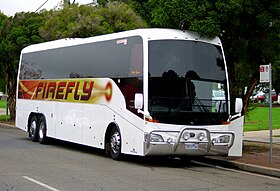This article needs additional citations for verification. (November 2021) |
| Scania 4-series | |
|---|---|
 Firefly Express Coach Concepts bodied Scania K124EB in Australia | |
| Overview | |
| Manufacturer | Scania |
| Also called | F94, K94, K114, K124, L94, N94 |
| Assembly |
|
| Body and chassis | |
| Class | City bus and coach chassis |
| Body style | Single-decker bus Single-decker articulated bus Double-decker bus Single-decker coach |
| Doors | 1 to 4 doors |
| Floor type | Low floor Step entrance |
| Powertrain | |
| Engine | |
| Power output | 220-420 hp |
| Transmission | Scania manual or ZF automatic |
| Chronology | |
| Predecessor | Scania 3-series |
| Successor | |
The Scania 4-series low floor city bus and coach range was introduced by Scania in 1997 as a successor to the 3-series bus range.
The 4-series bus range was first presented in September 1996, when the integral low-floor city bus OmniCity was revealed.[1] Production of the chassis range started in second half of 1997, and by the end of 1998 all worldwide production facilities had changed from 3-series to 4-series.[2] Unlike the 3-series, which was a range of 45 different chassis models, the 4-series is one basic chassis with different modular configurations depending on usage and customer needs. At launch there were a total of seven major configurations, presumably the F HB, K EB, K IB, L IB, L UB, N UA and N UB. These were later followed by the F HA, K UB, L IA, L UA and N UD. The first letter describing the position of the engine, and the last two letters describing areas of use. In marketing of the 4-series, Scania have generally only used the engine position (F/K/L/N), the engine displacement (9/11/12) and the series number (4), which is why we know them as F94, F114, K94, K114, K124, L94 and N94.
The 4-series was superseded in 2006 by the new Euro IV compliant bus and coach range consisting of the K-series, N-series and F-series. Some 4-series products have been available for a couple of years after this.
- ^ Low-floor bus first out in Scania's new bus range Archived 2015-07-04 at the Wayback Machine Scania 3 September 1996
- ^ Scania's 4-series highway buses launched in Latin America Archived 2015-02-26 at the Wayback Machine Scania 8 September 1998